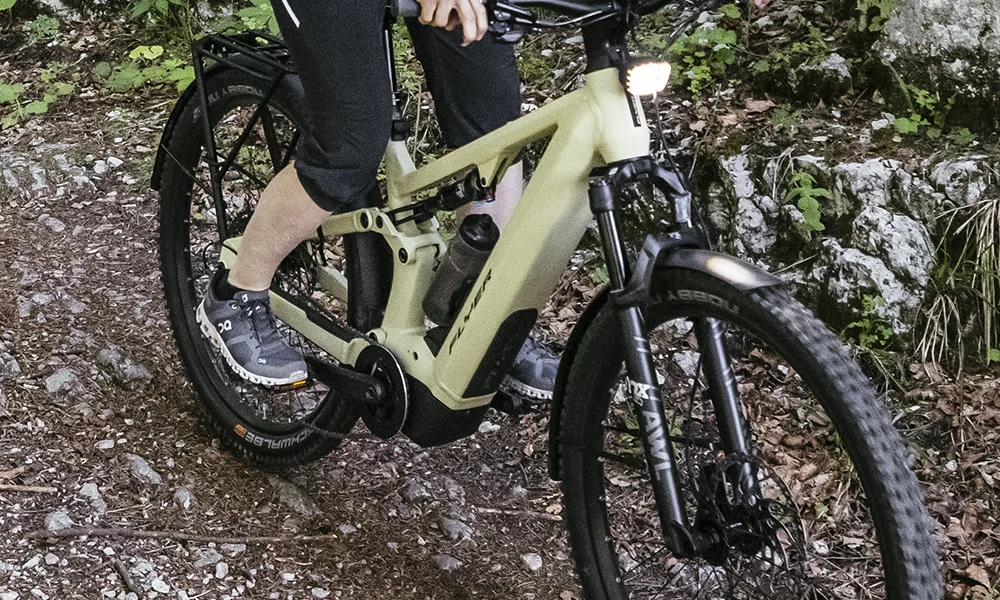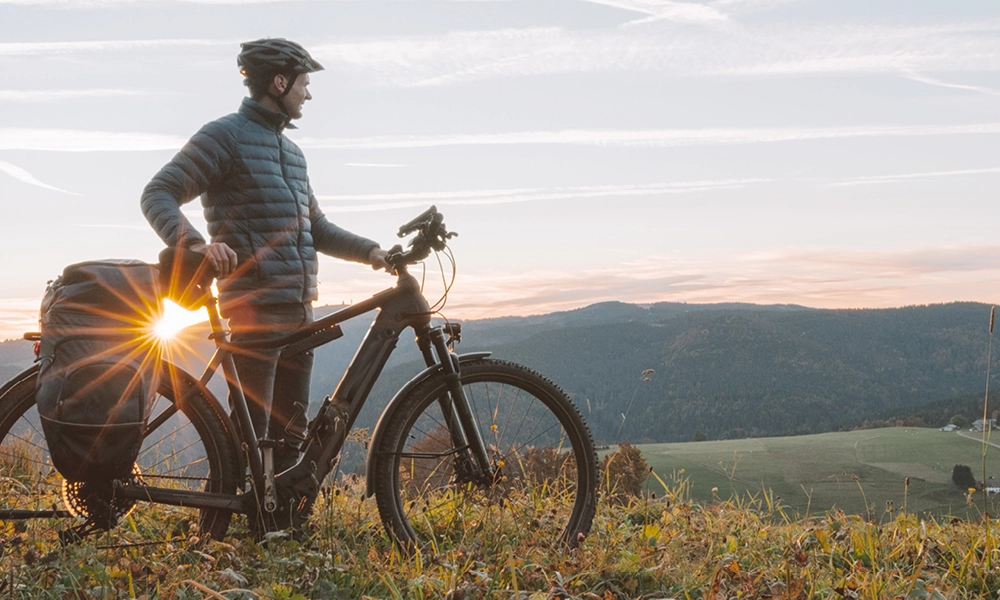FRENARE CORRETTAMENTE CON L'E-BIKE – ECCO COME RALLENTARE IN SICUREZZA
L’e-bike ha vissuto un enorme boom negli ultimi anni. Non c’è da meravigliarsi: coniuga la comodità di una normale bicicletta con l’indipendenza e il comfort di un veicolo elettrico. Tuttavia, anche se la guida di un’e-bike a prima vista non sembra diversa da quella di una tradizionale bicicletta, ci sono comunque alcuni fattori a cui dovresti prestare attenzione. Ne è un esempio l’impianto frenante. In quest’articolo ti spieghiamo come rallentare correttamente con un’e-bike.
GUIDARE UNA BICICLETTA NORMALE VS. GUIDARE UN E'BIKE
Azionare la leva del freno e rallentare la velocità: prima di affrontare il tema della frenata corretta, è importante capire in quali punti si differenzia la guida di un’e-bike da quella di una bicicletta classica. Infatti, anche se entrambi i tipi di bicicletta fanno fondamentalmente la stessa cosa, cioè ti portano da un posto all’altro, ci sono comunque alcune differenze di cui bisogna tenere conto. Le e-bike, ad esempio, sono generalmente più pesanti delle biciclette tradizionali. Il peso maggiore è dovuto alla loro motorizzazione elettrica. Inoltre, spesso possiedono pneumatici più grandi e più robusti, il che comporta anche una massa maggiore. Molte e-bike pesano spesso più di 20 chili, mentre le biciclette non motorizzate pesano per lo più tra i 10 e i 15 chili. Questo peso supplementare incide quindi sul comportamento di guida e di frenata. Il principio è noto dalla fisica: una massa maggiore significa una maggiore energia cinetica. Conseguenza: a parità di forza frenante, lo spazio di frenata diventa più lungo, oppure è necessaria una forza frenante maggiore.
Ma il peso non è l’unico fattore che influisce sulla frenata con l’e-bike. Le Pedelec sono di solito anche più veloci delle biciclette classiche. Grazie all’assistenza del motore possono raggiungere velocità più elevate. In particolare, le S-Pedelec, con la loro assistenza del motore, possono raggiungere fino a 45 chilometri all’ora, quindi vanno molto più velocemente di quanto si è abituati ad andare con una normale bicicletta. Anche questo punto deve essere tenuto in considerazione quando si deve frenare correttamente con una bicicletta elettrica.
QUALI TIPI DI IMPIANTI FRENANTI ESISTONO PER LE E-BIKE?
Per comprendere il tema «Frenare correttamente con l’e-bike» è inoltre opportuno dare un’occhiata ai diversi tipi di impianti frenanti presenti sulle biciclette elettriche. In bicicletta esistono di solito due tipi di impianti frenanti: il freno sul cerchio e il freno a disco. Il freno sul cerchio è il classico impianto frenante: viene azionato da una leva del freno presente sul manubrio e rallenta la ruota «afferrando» i fianchi del cerchio. Il freno a disco, invece, è un impianto frenante moderno, conosciuto soprattutto nel settore delle mountain-bike, ma sempre più utilizzato anche nelle e-bike. Funziona in modo simile a un freno sul cerchio, ma non agisce sul cerchio, bensì sul mozzo. Nel freno a disco, le pastiglie freno vengono spinte contro un disco che poggia sul mozzo.
Oggi nella maggior parte dei modelli di e-bike il freno a disco è l’impianto frenante preferito. Il motivo? il freno a disco è più costoso, ma offre alcuni vantaggi. È meno soggetto all’usura e offre prestazioni di frenata migliori anche sul bagnato. La potenza frenante complessivamente più elevata rispetto al freno sul cerchio contribuisce inoltre a compensare il peso maggiore della bicicletta e le velocità più elevate dell’e-bike (in altre parole, energia cinetica maggiore). Nella categoria dei principianti, i freni a disco funzionano di solito meccanicamente. I modelli più costosi, invece, funzionano con un sistema idraulico. Entrambi i tipi di freni sono offerti anche da produttori come Shimano, Sram, Tektro e Magura.


COS'ALTRO DEVI SAPERE SULL'IMPIANTO FRENANTE DELLA TUA E-BIKE
Regola generale: più grande è il disco freno di un’e-bike, maggiore è anche la potenza frenante della bicicletta elettrica. In questo contesto è assolutamente necessario prestare attenzione alle dimensioni massime del disco indicate dal produttore della ruota e dal produttore della forcella. Un ulteriore margine di miglioramento riguarda le pastiglie freno: esistono varie miscele per pastiglie freno che possono avere caratteristiche diverse. Nella maggior parte dei casi le pastiglie freno sono già premontate. Se vuoi sostituire le pastiglie freno, puoi scegliere tra fattori come la durata o l’effetto frenante.
Come tutti gli altri componenti sensibili della tua bicicletta, anche i dischi e le pastiglie dei freni dovrebbero essere puliti regolarmente dallo sporco. Si consiglia quindi di tenere lontano dall’impianto frenante tutto ciò che può ridurne l’effetto: lubrificanti, grassi, ecc. non devono essere applicati all’impianto frenante. È meglio utilizzare uno speciale prodotto per la manutenzione, specificamente adatto ai freni. Controllare le pastiglie e i dischi freno, in particolare all’inizio della stagione. Infatti, proprio dopo il lungo periodo di fermo invernale possono comparire segni di usura. Un consiglio: un’officina professionale controlla l’intero impianto frenante, in modo da poter iniziare la stagione primaverile in tutta tranquillità.
FRENARE CORRETTAMENTE CON L'E-BIKE – ECCO COME FRENARE NEL MODO GIUSTO
Come già spiegato all’inizio, il comportamento di frenata nell’e-bike è diverso da quello delle classiche biciclette. In particolare le velocità più elevate, il peso supplementare e il motore sono fattori che rendono difficoltosa la decelerazione con una Pedelec. La regola empirica «Frenare più forte davanti, più dolcemente dietro» vale tuttavia anche per le e-bike. Il motivo? se utilizzato correttamente, il freno anteriore ha un effetto frenante maggiore rispetto al freno posteriore. Ciò è dovuto alla distribuzione del peso che si sposta in avanti in fase di frenata. Se si utilizza il freno anteriore con una forza maggiore (ad esempio in rapporto 60:40), lo spazio di frenata diminuisce. In generale è utile tirare lentamente la leva del freno e applicare il massimo della forza solo poco prima dell’arresto. Altrimenti si corre il rischio di arrestarsi bruscamente e di essere improvvisamente proiettati oltre il manubrio.
Frenare correttamente con l’e-bike è quindi una questione di pratica. Il metodo migliore è esercitarsi su un percorso senza traffico e sviluppare la propria sensibilità verso l’impianto frenante. Chi ha dubbi può frequentare anche un corso sulle tecniche di guida. Qui imparerai come controllare correttamente la tua e-bike e viaggiare in modo più sicuro.
SEI CONSIGLI PER FRENARE CORRETTAMENTE CON L'E-BIKE
1. Per imparare a frenare correttamente con l’e-bike, è possibile esercitarsi su un percorso senza traffico. In questo modo avrai un’idea di come funziona il tuo impianto frenante e della potenza che riesce a sviluppare.
2. Importante è anche provare i freni in discesa a una certa velocità. La pendenza e la maggiore energia cinetica a essa associata aumentano notevolmente gli spazi di frenata.
3. Nella frenata in discesa è ampiamente collaudato il principio del «freno a scatti». Questo significa che è meglio frenare ripetutamente in modo più forte, che non costantemente in modo leggero.
4. Nelle e-mountain-bike moderne sono disponibili reggisella telescopici, che ti permettono di spostare più in basso il baricentro. Ciò garantisce una maggiore stabilità durante la frenata in discesa.
5. Acquisisci dimestichezza con l’impianto frenante della tua e-bike anche dal punto di vista tecnico. Così avrai una migliore visione d’insieme del funzionamento del tuo impianto frenante e avrai una maggiore sicurezza.
6. Fai eseguire regolarmente la manutenzione della tua e-bike dal tuo rivenditore di fiducia. In questo modo sarai sicuro che i freni della tua e-bike saranno sempre in ordine.
Ulteriori consigli e trucchi sulle e-bike sono disponibili negli altri articoli del blog:
02.05.2022

